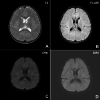Afebrile benign convulsions with or without a reversible splenial lesion in two pediatric patients with COVID-19
- PMID: 37101138
- PMCID: PMC10132411
- DOI: 10.1186/s12887-023-04025-x
Afebrile benign convulsions with or without a reversible splenial lesion in two pediatric patients with COVID-19
Abstract
Background: Seizures in children with coronavirus disease 2019 (COVID-19) were markedly increased during the Omicron variant surge. Most seizures occurred with fever. New-onset afebrile seizures were rarely reported; therefore, their courses are not well-known.
Case presentation: Two patients (7 and 26 months of age, respectively) with COVID-19 showed recurrent afebrile seizures immediately after resolution of a fever lasting for 2-3 days. Bilateral convulsive seizures lasted for approximately 1 min/episode (6 of 7 total episodes) and occurred 3-4 times within 2-3 h. However, the patients were alert between seizures, which is in contrast to seizures occurring with encephalopathy or encephalitis. Only one episode required acute antiseizure medication. Brain magnetic resonance imaging showed a reversible splenial lesion in one patient. The serum uric acid level was slightly increased (7.8 mg/dL) in this patient. Electroencephalography findings were all normal. During the follow-up period, no seizures or developmental problems have been observed.
Conclusions: COVID-19-associated, afebrile benign convulsions with or without a reversible splenial lesion are similar to 'benign convulsions with mild gastroenteritis'; therefore, continuation of antiseizure medication does not seem necessary.
Keywords: COVID-19; Child; Infant; Reversible splenial lesion; Seizures.
© 2023. The Author(s).
Conflict of interest statement
The authors have no potential conflicts of interest to disclose.
Figures

Similar articles
-
Splenial Lesions in Benign Convulsions With Gastroenteritis Associated With Rotavirus Infection.Pediatr Neurol. 2020 Aug;109:79-84. doi: 10.1016/j.pediatrneurol.2019.05.002. Epub 2019 May 9. Pediatr Neurol. 2020. PMID: 32303390
-
Mild encephalitis/encephalopathy with a reversible splenial lesion associated with systemic Mycoplasma pneumoniae infection in North America: a case report.J Med Case Rep. 2022 Feb 20;16(1):74. doi: 10.1186/s13256-022-03299-6. J Med Case Rep. 2022. PMID: 35183255 Free PMC article.
-
Reversible splenial lesion syndrome associated with SARS-CoV-2 infection in two children.Brain Dev. 2021 Feb;43(2):230-233. doi: 10.1016/j.braindev.2020.10.002. Epub 2020 Oct 13. Brain Dev. 2021. PMID: 33082059 Free PMC article.
-
Reversible splenial lesion syndrome in children: Retrospective study and summary of case series.Brain Dev. 2016 Nov;38(10):915-927. doi: 10.1016/j.braindev.2016.04.011. Epub 2016 Aug 30. Brain Dev. 2016. PMID: 27591118 Review.
-
Afebrile benign convulsions with mild gastroenteritis: a new entity?Acta Neurol Scand. 2009 Aug;120(2):73-9. doi: 10.1111/j.1600-0404.2008.01154.x. Epub 2009 May 6. Acta Neurol Scand. 2009. PMID: 19432878 Review.
References
-
- Ray STJ, Abdel-Mannan O, Sa M, Fuller C, Wood GK, Pysden K, et al. Neurological manifestations of SARS-CoV-2 infection in hospitalised children and adolescents in the UK: a prospective national cohort study. Lancet Child Adolesc Health. 2021;5:631–41. doi: 10.1016/S2352-4642(21)00193-0. - DOI - PMC - PubMed
Publication types
MeSH terms
Substances
Supplementary concepts
LinkOut - more resources
Full Text Sources
Medical

